Red-femured Milkweed Beetles and Showy Milkweed
In the Spring of 2024, a mountain lion killed a deer down by the creek near our house. I’d visit the site every couple of weeks, watching to see what happened to the carcass and checking out any interesting tracks. By late July, the deer carcass was mostly bones and dried deer skin. The deer was hard to find, because it was mostly hidden by a growth of Showy Milkweed (Asclepias speciosa) plants.
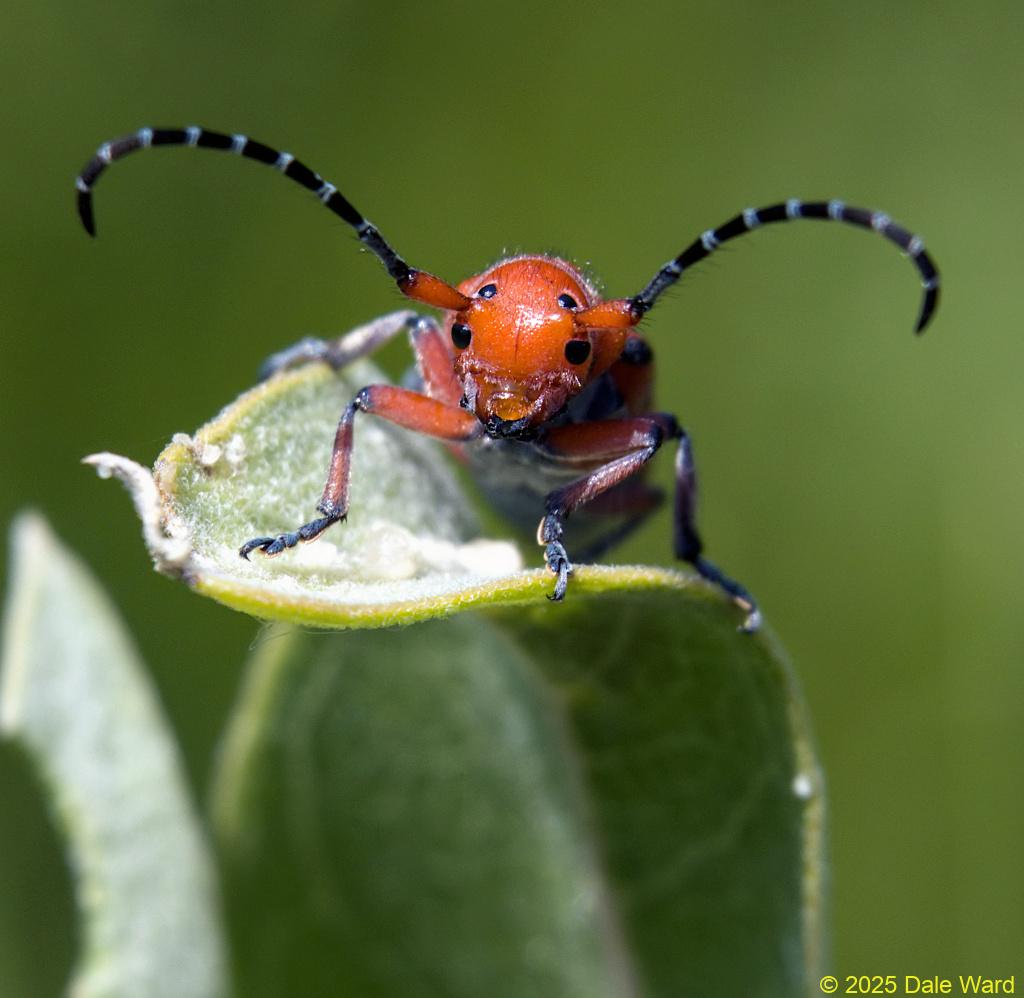 Red-femured Milkweed Beetle on Showy Milkweed leaf)
Red-femured Milkweed Beetle (Tetraopes femoratus) on a Showy Milkweed leaf. You can see the source of the ‘four-eyes’ part of its genus name comes from – it’s got four eyes!
Red-femured Milkweed Beetle on Showy Milkweed leaf)
Red-femured Milkweed Beetle (Tetraopes femoratus) on a Showy Milkweed leaf. You can see the source of the ‘four-eyes’ part of its genus name comes from – it’s got four eyes!
And the Milkweed had some beautiful red and black-spotted beetles feeding on it.
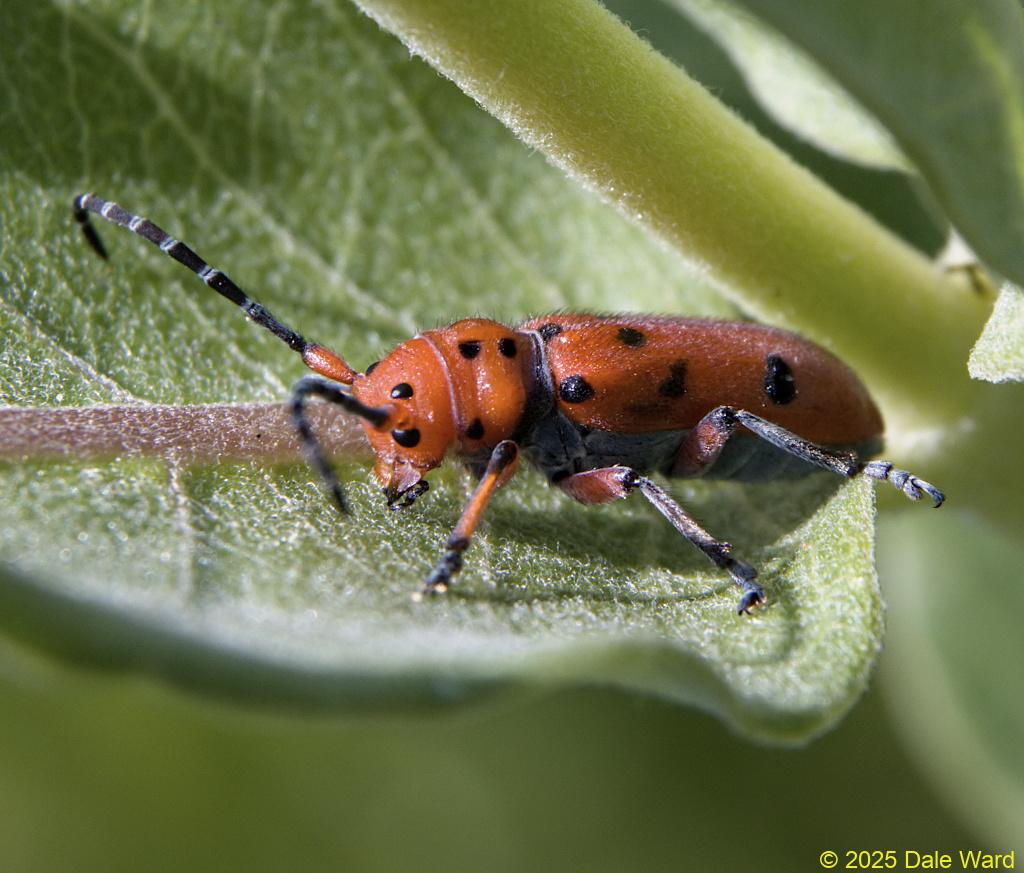 Red-femured Milkweed Beetle on Showy Milkweed leaf)
Red-femured Milkweed Beetle (Tetraopes femoratus) on a Showy Milkweed leaf.
Red-femured Milkweed Beetle on Showy Milkweed leaf)
Red-femured Milkweed Beetle (Tetraopes femoratus) on a Showy Milkweed leaf.
These beetles were “Milkweed Beetles” – a type of Long-horned (Cerambycid) Beetles They’re in the genus Tetraopes, meaning “Four-eyed”. Looking at the beetles, you can see where the name comes from – their antennae completely separate their compound eyes into upper and lower halves. So, in a way, they have four compound eyes. One eye above, and one below each of their two antennae.
Bugguide.net currently lists 14 species of Tetraopes in the US. Based upon the Chemsack and Noguera (2003) key , I think the beetles in these photos are Tetraopes femoratus - the “Red-femured Milkweed Borer Beetle”.
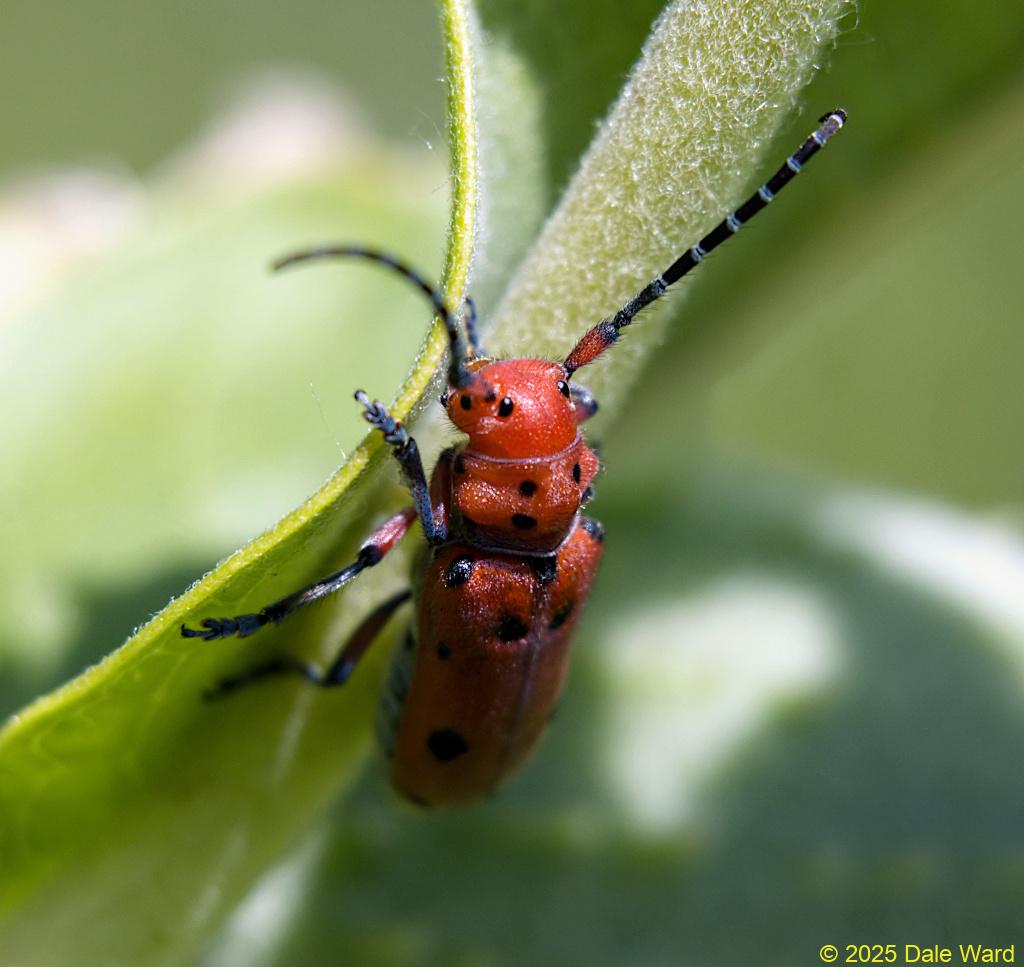 Red-femured Milkweed Beetle on Showy Milkweed leaf)
Red-femured Milkweed Beetle (Tetraopes femoratus) on a Showy Milkweed leaf.
These beetles are specialists on Milkweeds. Whenever I hear that a creature is a specialist on Milkweed, my ears prick up. There’s almost always an interesting story associated with creatures that eat Milkweeds.
Red-femured Milkweed Beetle on Showy Milkweed leaf)
Red-femured Milkweed Beetle (Tetraopes femoratus) on a Showy Milkweed leaf.
These beetles are specialists on Milkweeds. Whenever I hear that a creature is a specialist on Milkweed, my ears prick up. There’s almost always an interesting story associated with creatures that eat Milkweeds.
Milkweeds are fascinating plants. When damaged, they bleed a white, gluey (and toxic!) latex. I had always thought that this white latex was sap, coming from the Milkweed’s phloem. I wondered how such a thick, gluey substance as the latex could be used in a nutrient transport role in the plant. But the latex isn’t a type of phloem.
It turns out Milkweeds and some other plants have a system of cells that produce and contain a pressurized store of latex. These cells are called “lactifers”, meaning “milk producers” - presumably because the latex looks like thick, white milk. These lactifers form a system of elongate tubes that parallel the plant’s xylem and phloem network, its circulatory system. When one of the lactifers gets damaged, as by an herbivore taking a bite out of a leaf, the pressurized latex comes oozing out through the break in the lactiferous system.
This white latex is foul-tasting and sticky stuff. And as it dries, it thickens. If it got onto an insects mouth-parts, for example, it would probably glue them shut.
And yet the Milkweed Beetles do manage to eat the leaves. If you look in the photo below, you can see that the beetle has been eating the tip of the milkweed leaf, and its mouth-parts aren’t getting covered in gluey latex. Why not?
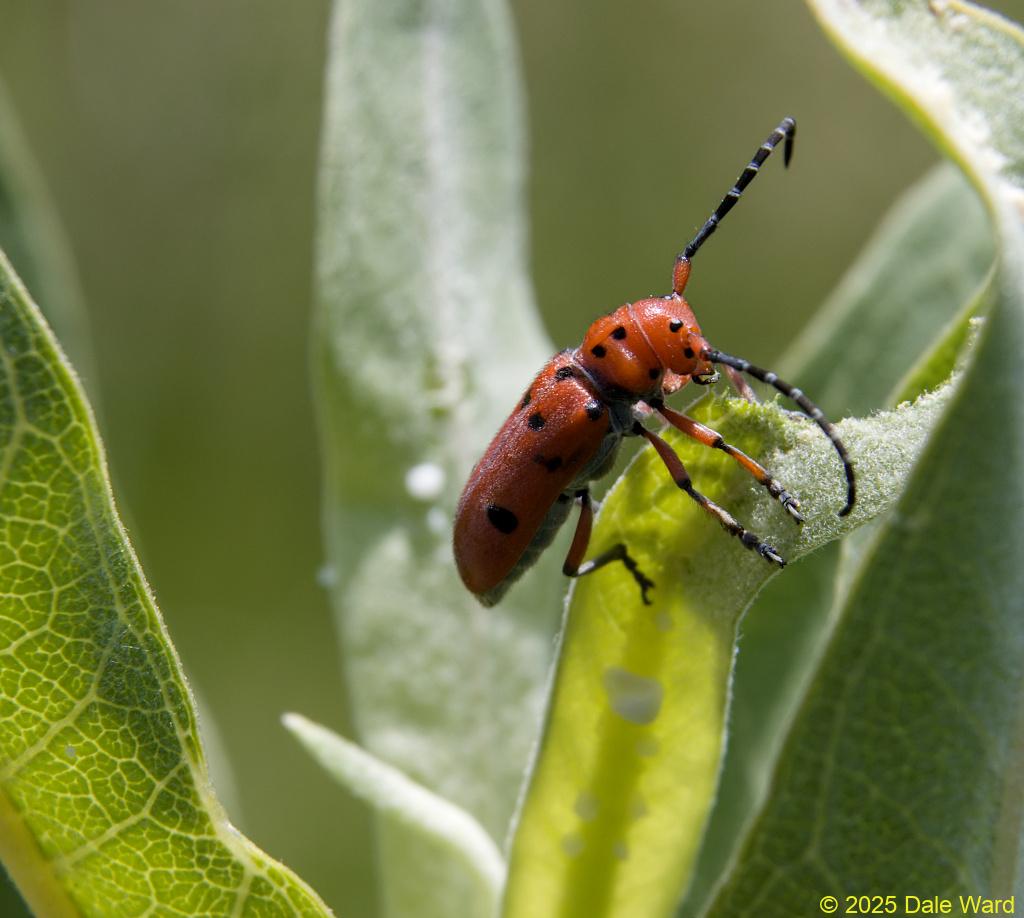 Red-femured Milkweed Beetle on Showy Milkweed leaf)
Red-femured Milkweed Beetle (_Tetraopes femoratus_) on Showy Milkweed leaf. On the leaf in the center-background, you can see a spot of latex from a vein-cut in the leaf. There is also a splotch of latex below the beetle - why isn’t the beetle getting all gummed up with latex?
Red-femured Milkweed Beetle on Showy Milkweed leaf)
Red-femured Milkweed Beetle (_Tetraopes femoratus_) on Showy Milkweed leaf. On the leaf in the center-background, you can see a spot of latex from a vein-cut in the leaf. There is also a splotch of latex below the beetle - why isn’t the beetle getting all gummed up with latex?
Prior to eating a milkweed leaf, the Milkweed Beetles bite into a leaf vein, so that it bleeds latex. Pressurized latex pours out of the beetle-cut vein. Now the distal, downstream portion of the lactiferous system, towards the leaf edge, will have far less pressure and therefore bleed far less latex when damaged.
And that’s where the beetles begin feeding, in the section of leaf that was previously protected by the now-severed vein.
The photo below has an image of one of the leaves that had been eaten, presumably by the Milkweed Beetles. The red arrow is pointing to an area that has an ooze of latex, and you can see what look like chew marks in the leaf vein just distal to the latex ooze.
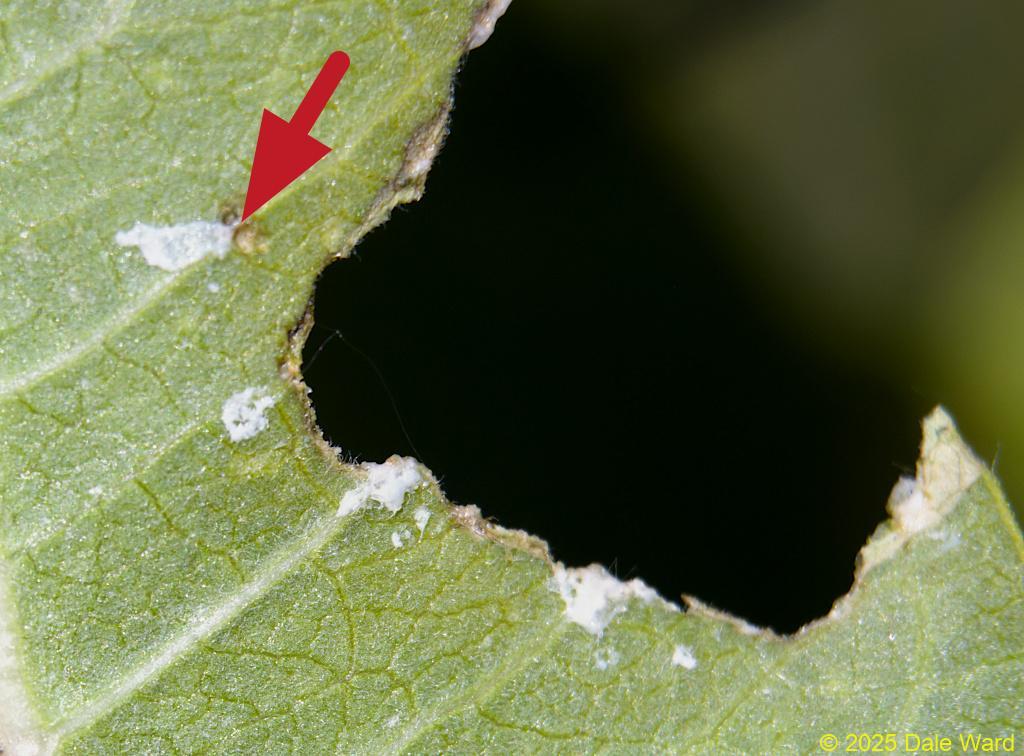 Red-femured Milkweed Beetle on Showy Milkweed leaf)
The chewed edge of one of the Milkweed leaves. The red arrow is pointing at a spot that looks like a cut in the vein. I’m guessing that there were also cuts at the other veins, too - but the beetle ate down to the site of the cuts.
You’ll notice that there are also veins that oozed latex right on the edge of the leaf damage. I suspect that the beetles cut all of those veins in the Milkweed leaf, and then ate the leaf down to the vein cuts. I’m thinking that the red arrow is pointing to a spot that they didn’t eat all the way down to the vein-cut.
Red-femured Milkweed Beetle on Showy Milkweed leaf)
The chewed edge of one of the Milkweed leaves. The red arrow is pointing at a spot that looks like a cut in the vein. I’m guessing that there were also cuts at the other veins, too - but the beetle ate down to the site of the cuts.
You’ll notice that there are also veins that oozed latex right on the edge of the leaf damage. I suspect that the beetles cut all of those veins in the Milkweed leaf, and then ate the leaf down to the vein cuts. I’m thinking that the red arrow is pointing to a spot that they didn’t eat all the way down to the vein-cut.
I’ve not seen these beetles sever the mid-vein on the these Elegant Milkweeds - I’ve only seen our local beetles sever the side veins of the milkweed leaf. In his book For Love of Insects, Thomas Eisner speaks about a different species of Milkweed Beetle, Tetraopes tetraopthalmus, that severs the mid-vein of Milkweed leaves. Perhaps which veins the beetles choose to sever is a function of the leaf size and shape?
Milkweed Beetles lay their eggs on the milkweed’s stem, near the ground. The larvae hatch, and bore into the stem and roots, feeding on the plant’s tissue. They overwinter in the roots of milkweed’s roots. One of the common names for the Milkweed Beetles is “Milkweed Borer Beetles”.
How do the larvae handle the latex? I don’t know. Perhaps there is less lactiferous tissue in the roots of the plants than in the leaves?
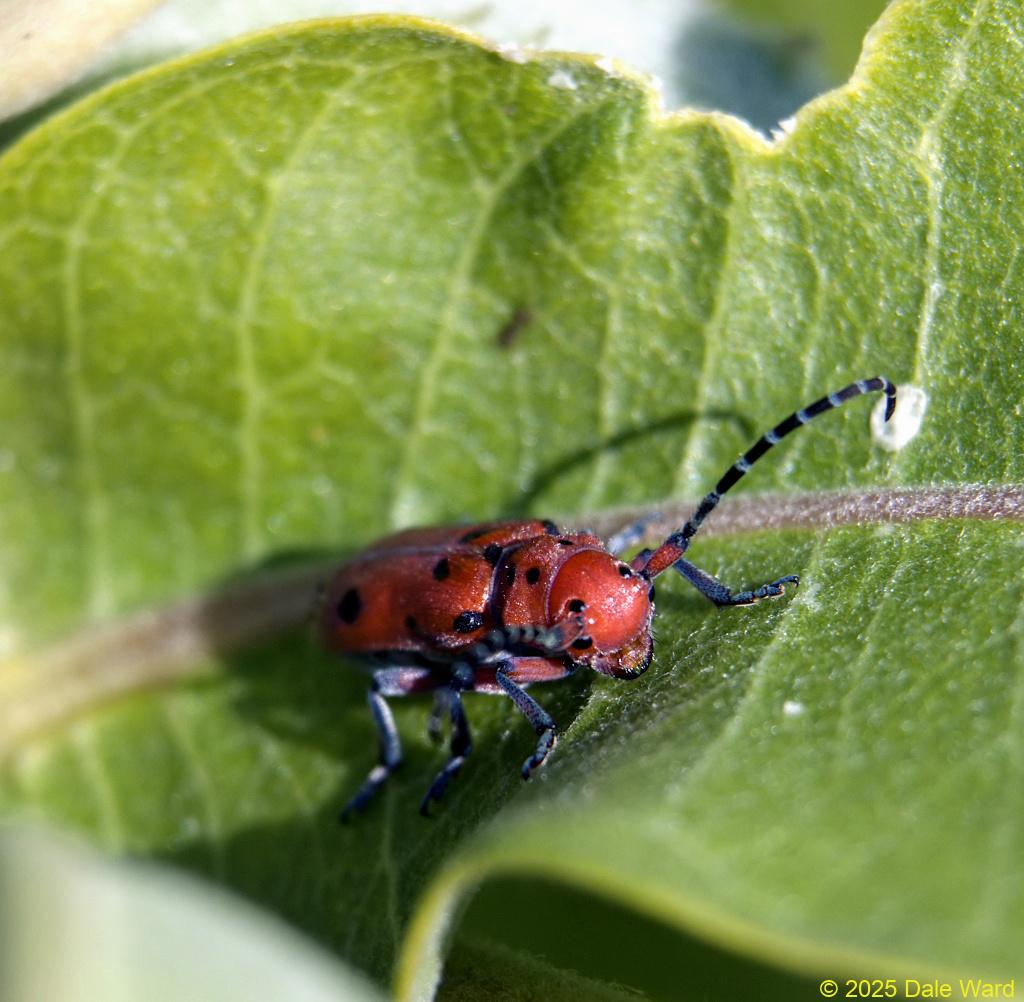 Red-femured Milkweed Beetle on Showy Milkweed leaf)
Red-femured Milkweed Beetle (_Tetraopes femoratus_) on Showy Milkweed leaf
Red-femured Milkweed Beetle on Showy Milkweed leaf)
Red-femured Milkweed Beetle (_Tetraopes femoratus_) on Showy Milkweed leaf
In addition to sticky, bad-tasting glue, milkweed leaves also contain cardiac glycosides. In vertebrates, these cardiac glycosides are toxins - they cause changes in the contractility of heart muscle, leading to irregular heartbeats and, in severe cases, death.
Milkweed Beetles sequester these toxins, using them as protection against would-be beetle predators. The Milkweed Beetles’ red-and-black spotted coloration serves as aposematic coloration: a warning to predators, saying “Don’t eat me, I’m toxic!”.
Maybe enhancing that red-and-black aposematic coloration could explain the way that the beetle’s compound eyes are fully divided by the antennae, making the beetle “four-eyed”. Other beetles in the family Cerambycidae have eyes that are partially divided by their antennae. Perhaps this “partially divided eye” tendency was amplified in the Milkweed Beetles, favored by selection because the separated eyes looked like black spots, enhancing the beetle’s pattern of warning colors?
Sources
Chemsak, J.A. and F. A. Noguera. 2003. New species of the genus Tetraopes Schoenherr (Coleoptera: Cerambysidae). The Pan-Pacific Entomologist - July 2003. 79(3/4): 237-244. [PDF Here] (https://www.researchgate.net/publication/292268006_New_species_of_the_genus_Tetraopes_Schoenherr_Coleoptera_Cerambycidae). A useful key.
Eisner, Thomas and Edward O. Wilson. 2003. For Love of Insects. Belknap Press, First Edition (November 30, 2003). ISBN 0674011813._
Eisner, Thomas, Maria Eisner, Melody Siegler. 2007. Secret Weapons: Defenses of Insects, Spiders, Scorpions and Other Many-Legged Creatures. Belknap Press: An Imprint of Harvard University Press (April 30, 2007). 384 pages. ISBN 0674024036._
Evans, Arthur V. 2021. Beetles of Western North America. Princeton University Press (September 28, 2021). ISBN 0691164282._
Marshall, Stephen A. 2018. Beetles: The Natural History and Diversity of Coleoptera. Firefly Books; Illustrated Edition (September 1, 2018). ISBN 0228100690.
Bugguide.net’s entry for Tentraopes - many thanks, again! Still!